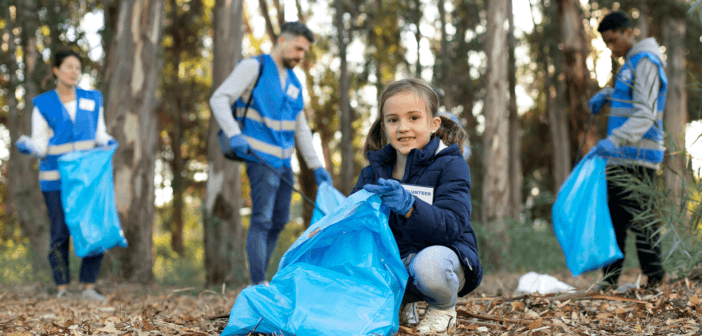How can parents shape a generous spirit in their children? Ken Sloane outlines ten practical ways families can focus more intentionally on giving and gratitude, compassion, and service so that their children grow in faith and generosity.
Who doesn’t want to see our children grow up knowing how to manage money wisely and generously — acknowledging that all blessings come from a generous God who wants our lives to be abundant and full of love and compassion? Unless we are intentional about teaching them, they have only what they will hear from the media and marketers about what gives life joy. Here are ten ways to make our homes places where children will learn about a generous spirit.
1. Rotate giving stories into your bedtime story rotation.
The experience of reading stories together creates powerful memories for both parents and children. As adults in their thirties, my son and daughter remember the silly lines from Goodnight Moon and In the Night Kitchen. What an amazing opportunity to imbed generosity into that shaping process! Click here for a starting place to look for some ideas.
2. Add a give and a save element into children’s allowances.
This implies that parents are giving an allowance and, of course, that family finances can support an allowance. According to a recent T. Rowe Price survey of parents of children ages eight through fourteen, 68 percent of those parents gave an allowance to their children; more than half gave ten dollars or less. The benefit of an allowance is that it helps children learn about money management. How much more could children learn about money and life if their allowance were increased from, say, ten dollars to twelve dollars, and one dollar was designated for saving and one dollar was designated for giving away? One friend uses this plan with his children; and when the children find something where they want to give, the parents will often match the gift for even greater impact and joy!
3. Once a week, ask every family member to list a kindness someone did for you and a kindness you did for someone else.
Family schedules can be crazy these days (soccer, gymnastics, band, ballet), and many are finding that a family dinner — everyone present, not racing to make it to the next practice — is rare. If you can pull off one family dinner a week (maybe on the weekend), use a simple question to get your family focused on how they have extended generosity and how generosity has been extended to them.
4. Compile a list of movies that highlights generous acts and include those movies in family viewing. Spend a few minutes discussing them when the movies are over.
In those dark days before there were Netflix, DVDs, VHS, or even cable, I grew up in a world of only three to six channels on TV. (I grew up in a New York City suburb and was privileged with more than the two or three channels some of my contemporaries had.) Movie night was a big deal, whether the movie was The Wizard of Oz, The Ten Commandments, or King Kong (the Fay Wray version). Thanks to the pandemic and our hunkering down, I’m hopeful that the movie night tradition has made a resurgence. Add to your lists some films that teach about the power of giving and the joy it can bring. Pay It Forward was a favorite of mine to watch with my kids (now grown), but a little internet searching will turn up some ideas that will fit your family/audience. See “12 Films That Will Encourage Your Kids to Spread Love Through Acts of Service.”
5. Find a local charitable nonprofit that allows families to volunteer together.
A family day of service can make a lasting impression on children and teens. I continually meet adults involved in ministry or some form of career of service and caring who will cite a family experience of mission that set their trajectory. Older children can help side by side with their parents in serving meals to people who are homeless or on the margins. Some nonprofits would be thrilled to have a family come and repaint a room or work on a mural. Many thrift shops are thrilled to have volunteers — even those with younger children — who sort through trash bags full of donated clothes and separate them into men’s and women’s, boys’ and girls’. Even an annual tradition of this kind of service (I know a church that does a day of service to mark the Martin Luther King Jr. holiday) can leave a lasting impression!
6. Adopt a family mission project with a measurable, attainable goal.
A family mission project does not necessarily have to take you away from home. It’s especially exciting when there’s a goal that you can aim for and achieve: a box of groceries for a family of four to have for their Thanksgiving dinner; weekend “backpack food” for a child in the local elementary school. Partner with an agency that knows the needs and the sensitivities. Another great example is United Methodist Committee on Relief (UMCOR) relief supplies — in great demand when natural disasters happen (and replenishing is always needed afterward so they are ready for the next crisis).
7. Plan a garage/yard sale and make a family decision about where to donate the proceeds.
Have a garage full of stuff too good to give away (or stuff you just really didn’t want to deal with)? Do your kids have stuff squirreled away in closets or under their beds that they don’t use or have moved beyond? A family garage/yard sale is a great way to unclutter your lives a bit, and it can also be a great chance to make a significant donation to an organization that does good work in helping where there is a great need. Two simple suggestions to optimize the impact of this event: (1) Each family member should be in on the decision about what cause (or causes) will receive the donation, and (2) Each should be free to decide what he or she wants to make available for the sale! These will help everyone feel ownership of the act of helping through their donations.
8. Replace or supplement birthday and holiday gifts with a donation to a nonprofit that is specially aligned with the recipient, or offer an act of service.
Remembering that not all family members are children and youth provides the opportunity to note that not all gifts have to be “things.” A contribution to a cause near and dear to the heart of the recipient — to an animal rescue center for a dog or cat lover; to a community garden or farming project for an avid gardener could be a more meaningful and joyful gift for the person who has limited space and doesn’t really need more stuff. The donation might also be in service: giving a Saturday of service at a feeding program or at an animal shelter in honor of a parent’s or grandparent’s birthday will go a long way toward reinforcing the idea that we can practice generosity by giving time and talent as well as money.
9. Brainstorm as a family some random acts of kindness you can do without anyone knowing or getting any recognition.
This can be a fun way to drive home the idea that the joy of generosity is often at its best when it is done in secret (as Jesus reminded us in Matthew 6:3). Whether it is secretly picking up someone else’s check when you are out for lunch, paying for the order for someone behind you in the fast-food drive-up window line, raking an elderly neighbor’s yard or shoveling their walk, the joy of random acts of kindness can open our eyes to new ways of looking at how we invest our lives.
10. If it’s within your means, consider endowing a gift.
Most of us feel like the world of endowments and philanthropy are only for the wealthy. How many times have we speculated on the good we would do if we won the lottery or if a large sum of money fell into our laps? An endowment is gift that, when invested, can produce income for a cause year after year after year. Some endowments do require a large initial gift, but not all. A partial scholarship for a week of church camp for a child whose family is struggling might be accomplished with an endowment of $1,000 — less than $100 a month set aside over a year. If that same amount continued to be set aside and invested for another year, a full scholarship (or partial for two children) could open the door to a life-changing experience for a young person.
This article was originally published by Discipleship Ministries. Used by permission.
Related Resources
- How Parents Help Children Grow in Faith by Ann A. Michel
- Teaching Children to Tithe by Dan Pezet
- 4 Ways to Help People Cultivate a Heart of Gratitude by Ann A. Michel







